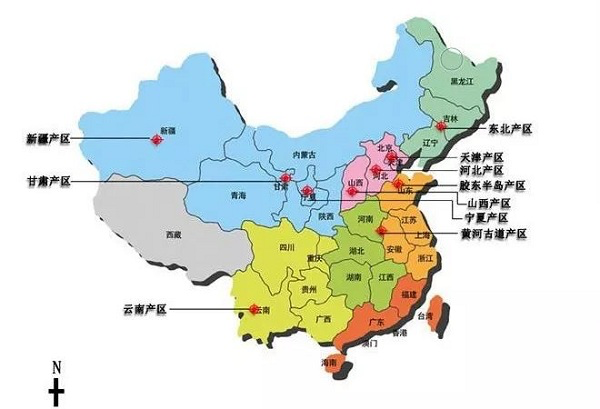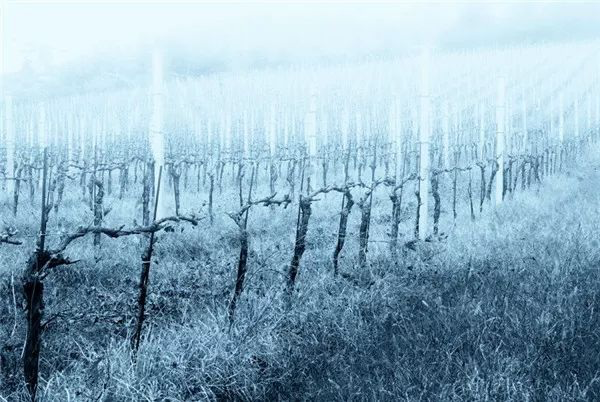China's grape planting areas are relatively scattered , and can be divided into large producing areas: Shandong Peninsula producing area, Hebei producing area, the eastern foot of helan mountain in Ningxia area, Xinjiang producing area, Yunnan producing area, Northeast producing area, Qingxu,Shanxi producing area And Wuwei ,Gansu production area.

In terms of production, shandong peninsula is the largest wine producing region in China, accounting for 40% of the country's total. In 1982, China's first modern winery, Chang Yu, was established here. Yantai and Penglai have the same latitude as Bordeaux, and the climate has certain similarities. They are close to the sea. They belong to a typical marine climate, and they are warmer in winter. However, in the Shandong Peninsula, the growing season of grapes faces monsoons and high rainfall, and there is a risk of mold disease in late summer and early autumn. The main varieties here are Cabernet Sauvignon, Merlot and Serpent Dragon Ball.
There are about 38,000 hectares of vineyardsin theeastern foot of helan mountain in Ningxia,It is the second largest wine producing region in China, with a total of about 200 wineries, most of which are locatedin theeastern foot of helan mountain in Ningxia, The Ningxia region is also dominated by Bordeaux grape varieties, including Cabernet Sauvignon, Merlot and Serpentine. Unlike Shandong, Hebei and other production areas occupied by large-scale production of large brands, although Ningxia also has a large scale such as the West Pigeon Winery, but this is also where small boutique wineries gather. Wine master Jancis Robinson once said that the future of Chinese wine is Ningxia.
The Hebei region is China's third-largest wine-producing region, with 13,000 hectares of vineyards, and the Great Wall, one of the country's largest producers, is located here. Huailai production area includes the three counties of Xuanhua, Zhuolu and Huailai in Hebei. It is located in the hilly area to the north of the Great Wall and northwest of Beijing. The climate is dry throughout the growing season, with large temperature differences between day and night, low rainfall, and soil with high sand content, which is suitable for grape growth. The main varieties are Cabernet Sauvignon, Merlot and Shiraz.
Xinjiang is a region with extreme climate. It is very arid, with little rainfall and huge temperature difference between day and night. Therefore, the wines produced here are often high in residual sugar and low in acidity. Although the local sales are still good, the taste is still flat in terms of quality. For Xinjiang, transportation is also a problem, so most of Xinjiang's wines are shipped out in bulk and then bottled at other large companies. Cabernet Sauvignon, Cabernet Franc and Chardonnay。
When it comes to Yunnan, many people are surprised: Yunnan's latitude is between 20 degrees and 28 degrees. So, even in the south, can wine be produced? Generally speaking, tropical areas are not good, but the Shangri-La Mountains in Yunnan has an altitude of 2,600 meters, which just offsets the impact of latitude. Yunnan's wine grapes are also very special. In addition to Cabernet Sauvignon and Merlot, which are grown everywhere, Yunnan also has two main varieties: rose honey and French wild. These two breeds are almost extinct in Europe, but were brought to China by French missionaries in the second half of the 19th century, but were preserved in this way.
The northeast producing area mainly includes the foothills of Changbai and the Northeast Plain south of 45 degrees north latitude. The winter here is extremely cold, and the temperature is as low as -30 to 40 degrees Celsius. The common European varieties used for winemaking cannot survive. Therefore, the northeastern region mainly produces native wild mountain grapes, mainly concentrated in the Tonghua producing area.

Qingxu producing areas include Fenyang, Yuci in Shanxi and the northwest mountainous areas in Qingxu. It has a typical continental climate, with four distinct seasons, drought, little rain, strong sunlight, and large temperature differences between day and night. The soil is gravel-containing sandy loam, which is an ideal area for wine grapes.
Wuwei production areas include counties and cities located on the edge of the Tengger Desert, such as Wuwei, Minqin, Gulang, and Zhangye in Gansu Province. They are also an emerging wine production area on the China Silk Road. The climate here is cold and dry, with insufficient heat and cold in winter, suitable for early-to-maturity varieties. In recent years, more Merlot, Pinot Noir and Chardonnay have been planted.